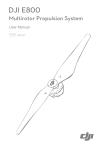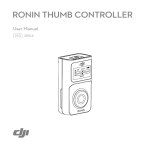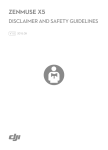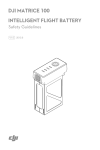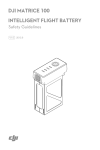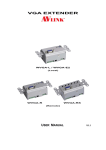Download DJI E1200 Standard
Transcript
DJI E1200 Standard Tuned Propulsion System User Manual V1.0 2015.5 Disclaimer Thank you for purchasing the E1200 Standard Tuned Propulsion System (hereinafter referred to as “product”). Read this disclaimer carefully before using this product. By using this product, you hereby agree to this disclaimer and signify that you have read it fully. Please install and use this product in strict accordance with the User Manual. SZ DJI Technology Co., Ltd. and its affiliated companies assume no liability for damage(s) or injuries incurred directly or indirectly from using, installing or refitting this product improperly, including but not limited to using non-designated accessories. Ensure that your ESC firmware is up-to-date and is compatible with the motor you will attach it to. Otherwise, you will be responsible for all resulting consequences caused by your own actions. This device complies with part 15 of the FCC Rules. DJI is the registered trademark of SZ DJI Technology Co., Ltd. (abbreviated as “DJI”). Names of products, brands, etc., appearing in this manual are trademarks or registered trademarks of their respective owner companies. This product and manual are copyrighted by DJI with all rights reserved. No part of this product or manual shall be reproduced in any form without the prior written consent of or authorization from DJI. This disclaimer is produced in various languages. In the event of variance among different versions, the Chinese version shall prevail when the product in question is purchased in Mainland China, and the English version shall prevail when the product in question is purchased in any other region. Warnings When powered on, the motors and propellers will rotate very quickly and can cause serious damage or injury. Always be vigilant and make safety your top priority. 1. Always attempt to fly your aircraft in areas free of people, animals, power lines, and other obstacles. 2. Do not approach or touch the motors or propellers when the unit is powered on. 3. Ensure that there are no open circuits or exposed wires that can cause short circuits. 4. Before flying, ensure that the propellers and motors are installed correctly and that the propellers are unfolded. 5. Check to ensure that all parts of the aircraft are in good condition before flying. Do not fly with worn or damaged parts. 6. Only use compatible, authorized DJI parts. Legend Important Hints and Tips If you encounter any problems or if you have any questions, please contact your local DJI authorized dealer or DJI Support. DJI Support Website: www.dji.com/support © 2015 DJI. All Rights Reserved. 1 EN About The E1200 Standard Tuned Propulsion System is a multirotor propulsion system that is designed for multi-rotor aircraft with payload limits of 7~15 kg. The E1200 Standard is more efficient and secure, and has better endurance. The Z-Blade 17-inch foldable propellers are made from an advanced carbon-fiber-reinforced polymer, which reduces rotational inertia and enhances rigidity. New, upgraded 4216 motors promote efficient heat dissipation which improves endurance and reliability, even when flying in harsh environments. The 640S Smart ESCs feature a sinusoidal drive, which is more efficient and allows for greater agility. Highly visible LED indicators show real-time motor status information, making flying even safer. Furthermore, the ESC firmware can be upgraded by users, effectively future proofing the E1200. EN 1. In the Box 4216 Motor (Clockwise rotation) ×1 4216 Motor (Counter-clockwise rotation) ×1 1760 Foldable Propeller (Clockwise) ×1 1760 Foldable Propeller (Counter-clockwise) ×1 640S ESC ×2 Outer ESC LED Indicator ×2 Accessory Package Screws for foldable propellers (M3×12.5 hexagon) Screws for propeller mount cover (M3×8) JST 3-Pin Cable ×2 Propeller Washers 2. Gain Value Setting The new E1200 Standard ESC features a sinusoidal drive, which replaces the traditional square wave drive to offer improved performance when accelerating and decelerating. To achieve the same sensitivity as older ESCs, which use a traditional square wave drive, reduce the gain values according to your flight control system and frame. The table below shows typical gain values when using the E1200 Standard with a DJI A2 flight control system and a frame which has a diagonal wheelbase of 920 mm and a takeoff weight of 8 kg: Basic Attitude Pitch Roll Yaw Pitch Roll Vertical 100% 100% 90% 150% 150% 100% 2 © 2015 DJI. All Rights Reserved. 3. Connecting the ESCs Tools Required Tools: Power hub, electric soldering iron and soldering tin Use: To solder each ESC’s power cable to the power hub 1) Please solder each ESC to the power pads on the power hub as shown in the figure below. Make sure that the solder is firmly attached to the power pads and that there is no possibility for a short circuit. The power cable is a coaxial power cable. Do not damage the protector on the red cable to avoid short circuits. 2) Connect the signal cable to your controller. The signal cable’s orange wire is for the control signal, the signal cable’s brown wire is for the GND, and the red wire is reserved. 3) Connect the motor to the ESC. Test the motor and ensure that the rotation direction of each motor is correct. If not, switch the position of any two cables connecting the motor to the ESC to change the rotation direction. ESC signal cable To the controller Power cable Power hub ESC Motor Take the power hub in the figure for example. The outer power pads are for the GND cables, and the inner power pads are for the power cables. The red core of the coaxial power cable is positive, and the shielding layer of the coaxial power cable is negative. Make sure to solder them correctly. Try to solder the cables firmly to the power hub at the proper length (the wires should be just long enough to reach the soldering point, face outwards, and should not be bunched up in front of the soldering point). Make sure that there are no open circuits or exposed wires that can cause short circuits. It is recommended that you solder a power connector onto the power hub. 4. Mounting the Motors Mount each motor to a frame arm according to the motor dimensions and the size of the assembly hole. 4×M3 Thread depth 4 mm 4×M3 Thread depth 4 mm 30 mm 35 mm 47 mm 48.7 mm 30 mm 12 mm 18 mm The screw size is M3. Mount the motors using the appropriate screws. Note the thread depth and the size of the screws. Using screws that are too long or too large may damage the motor. © 2015 DJI. All Rights Reserved. 3 EN 5. Assembling the Propellers The propeller cover mounting screws (M3×8) should be adjusted using an appropriate hex key. 1) The propellers marked CW should be mounted to the clockwise rotating motors, which have a mark. The propellers marked CCW should be mounted to the counter-clockwise rotating motors, which have a mark. 2) Use two propeller cover mounting screws (M3x8) to mount and secure the propellers. First line up and apply thread locker into the thread of the propeller mount, then tighten the screws. CW or CCW Mark EN Screws for Propeller Cover (M3×8) Clockwise Counter-clockwise Loose screws cannot be securely locked in place with thread locker. 6. ESC Port Description There are two ports on every ESC. They are the Outer ESC LED Port and the Data/ESC Firmware Update Port. These ports will be clearly marked on the ESC. Ensure that the ESC firmware is up to date and is compatible with the motor you will install. Refer to the tag on the back of the ESC to see the default version of the firmware. Mount the outer ESC LED Indicators according to your needs. The Data/ESC Firmware Update Port is used to update the ESC firmware and adjust the ESC. To do this, visit the official DJI website to download the DJI ESC Assistant. http://www.dji.com/product/e1200-standard/download 7. Using the DJI ESC Assistant The DJI ESC Assistant is used to upgrade the ESC’s firmware, configure the propulsion system, etc. An Updater is required and is not included with the E1200 Standard. To use the DJI ESC Assistant, connect the ESC to a computer through the Updater, as shown below. 4 © 2015 DJI. All Rights Reserved. ESC Updater Computer Before using the Updater, unplug any other serial devices that are connected to your computer, then follow the instructions below: 1) Download the DJI ESC Assistant from the official DJI website. Run the installer and follow the prompts to complete the installation process. 2) Connect one end of the Updater to the Data/ESC Firmware Update Port. Connect the other end of the Updater to a PC with a Micro-USB cable. Turn on the ESC system by connecting it to a 6S LiPo battery and do not disconnect the ESC from the computer until the configuration is complete. 3) Run the DJI ESC Assistant software and wait for the ESC to connect to the program. Watch the indicators at the bottom of the screen. When the ESC has been successfully connected, the ‘Computer Connection’ status will be solid green and the Data Exchange Indicator will blink blue. 4) Click the ‘View’ Tab. In the ‘ESC’ Section, check the current firmware version and ensure that the installed firmware is up-to-date. If it is not, click the link and follow the prompts to update it. 5) In the ‘LED Color’ Section, customize the colors of the ESC LED indicators. If the ESC is not automatically recognized by the DJI ESC Assistant (the indicators at the bottom of the screen will show a solid green and inactive blue color if not connected), check whether there is more than one DJI Updater, FTDI USB adapter or other developer tool (including, but not limited to BeagleBone, Raspberry, Arduino, etc.), which may use the FTDI chipset, connected to the computer. If any of these FTDI devices are connected, simply unplug them and keep the DJI Updater connected to the computer. Then, restart the DJI ESC Assistant and the ESC system, and the two should connect. 8. ESC LED Indicators & Sound Definitions The definitions are the same for both the outer ESC LED Indicators and inner ESC LED Indicators, as shown below: LED Indicators Yellow-Green, blinking in turn / Red or Green, blinking slowly —/ — Solid Red or Green Red-Yellow, blinking in turn Yellow, blinking quickly Sound Description None Motor is connecting 1356 Ready None Motor has started normally None Self-test failure BB---BB---BB… Input voltage is abnormal BBB----BBB… The motor’s parameters don’t match the firmware data saved in the ESC BBBBBB… Throttle stick is not at the bottom position © 2015 DJI. All Rights Reserved. 5 EN Yellow, blinking slowly —Solid Yellow Red, blinking quickly B------B------B… No signal input None Motors are rotating at full throttle None Error, land your aircraft immediately* * Learn more about the possible errors by connecting the ESC to the ESC Assistant. You can instantly tell what the unit’s status is by observing the LEDs and listening to the sounds emitted from the ESC. EN 9. Specifications Max. Thrust 3900 g/rotor (25 V, Sea Level) Takeoff Weight (Recommended) 1200 ~ 1400 g/rotor (Sea Level) Takeoff Weight (Max.) 1700 g/rotor (Sea Level) Battery (Recommended) 6S LiPo Working Temperature -10 ~ 60°C ESC Max. Allowable Voltage 26 V Max. Allowable Current (Persistent) 40 A PWM Input Signal Level 3.3 V / 5 V Compatible Signal Frequency 30 ~ 450 Hz Battery 6S LiPo Weight (with cable) 72 g Weight (without cable) 35 g Motor Stator Size 42×16 mm KV 310 rpm/V Weight 205 g Propeller Diameter / Thread Pitch 17×6 inch 10. FAQs Remounting the Propellers 1) Use the two Foldable Propeller mounting screws (M3×12.5 hexagon), the two Propeller Cover mounting screws (M3×8), and the four propeller washers to remount the propellers. 2) First line up and apply thread locker into the thread of the propeller mount, then tighten the screws until the propeller blades are securely clamped and can rotate freely. 6 © 2015 DJI. All Rights Reserved. Screws for Propeller Cover (M3×8) Screws for Foldable Propellers (M3×12.5 hexagon) Propeller Washers Loose screws cannot be securely locked in place with thread locker. EN Caution-Propellers Check the marks on the screws and propeller covers before every flight. If the propellers are loose, the marks will not line up, indicating that the screws should be tightened. If the two screws on the Foldable Propellers are switched or if other screws are used to mount the propeller, the marks may not be accurate. © 2015 DJI. All Rights Reserved. 7 The content is subject to change. Download the latest version from http://www.dji.com/product/e1200-standard If you have any questions about this document, please contact DJI by sending a message to [email protected]. © 2015 DJI. All Rights Reserved.










